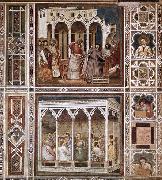Wholesale Oil Painting Reproductions No Minimum and Door to Door! |
|||||||||||
|
|
|||||||||||

|
|||||||||||
|
|
|
||||||||
All GIOTTO di Bondone Oil Paintings |
||||||||
|
|
||||||||
|
|
||||||||
|
Artist Introduction: Italian Early Renaissance Painter, 1267-1337
Italian painter and designer. In his own time and place he had an unrivalled reputation as the best painter and as an innovator, superior to all his predecessors, and he became the first post-Classical artist whose fame extended beyond his lifetime and native city. This was partly the consequence of the rich literary culture of two of the cities where he worked, Padua and Florence. Writing on art in Florence was pioneered by gifted authors and, although not quite art criticism, it involved the comparison of local artists in terms of quality. The most famous single appreciation is found in Dante's verses (Purgatory x) of 1315 or earlier. Exemplifying the transience of fame, first with poets and manuscript illuminators, Dante then remarked that the fame of Cimabue, who had supposed himself to be the leader in painting, had now been displaced by Giotto. Ironically, this text was one factor that forestalled the similar eclipse of Giotto's fame, which was clearly implied by the poet. |
||||||||
|
|
||||||||
|
Decorative bands Painting ID:: 62976 |
1304-06 Fresco Cappella Scrovegni (Arena Chapel), Padua The decorative bands on the walls above contain several scenes from the Old Testament and busts of saints and prophets. The Old Testament scenes are of a very modest standard, and owe their presence in the chapel to the Gothic tradition of representing parallels between the Old and New Testament. Some of the figures of saints and prophets are of very high workmanship, and among the most impressive of Giotto's repertoire. The two scenes on this wall detail are from the life of Christ: 11. Expulsion of the Money-changers from the Temple and 20. Mourning of Christ. Artist: GIOTTO di Bondone Painting Title: Decorative bands , 1301-1350 Painting Style: Italian , , religious |
|||||||
Height Width |
INS/CM Quality |
|||||||
|
X |
| |||||||
|
|
||||||||
|
Prev Next
|
||||||||
|
|
||||||||
|
Related Paintings to GIOTTO di Bondone :. |
||||||||
|
|
||||||||
|
CONTACT US |

